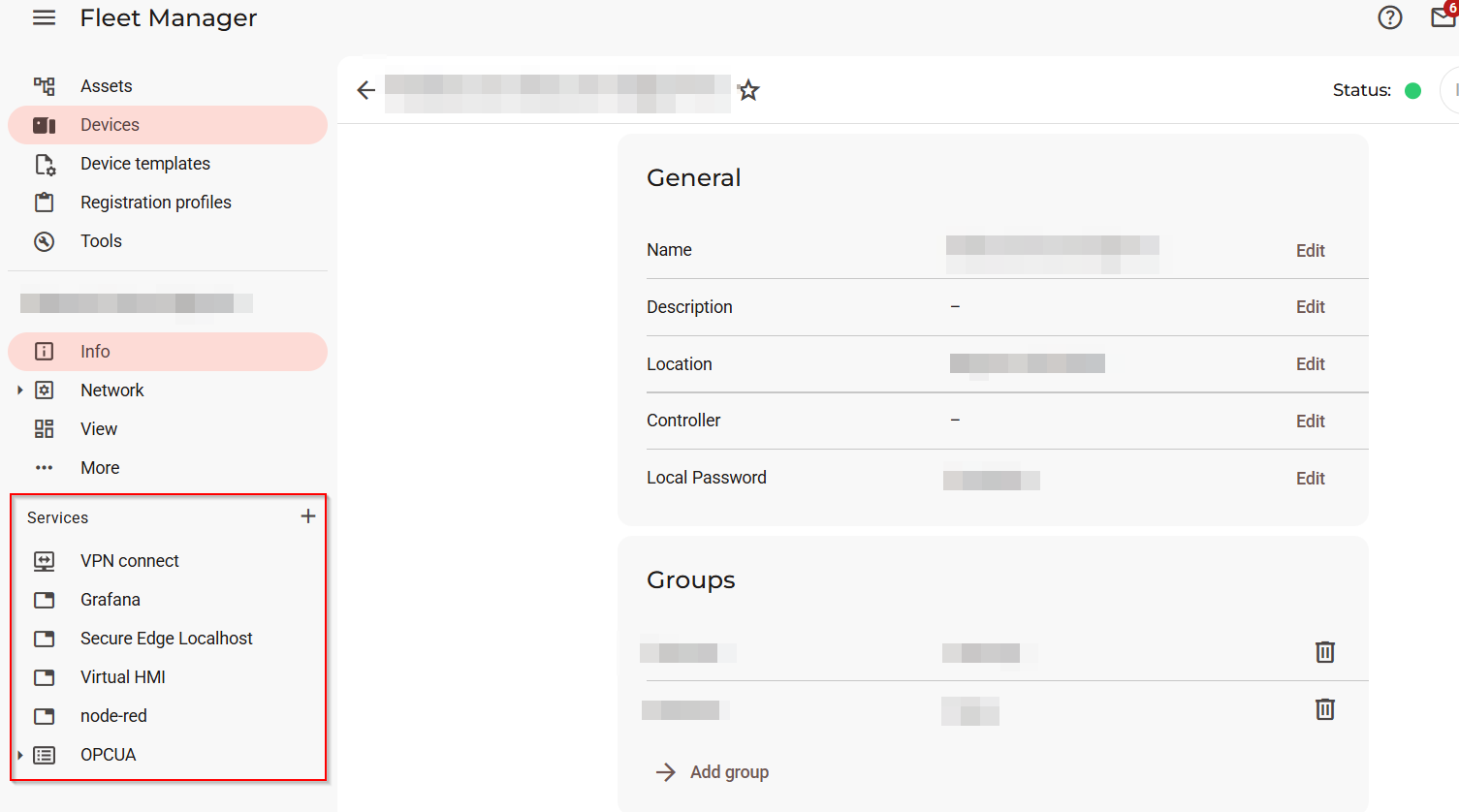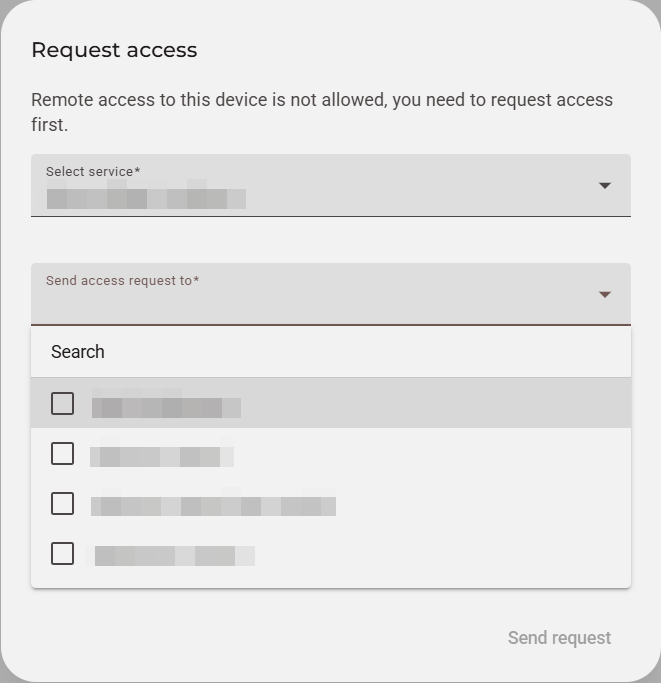Manage access requests
This article will explain how to work with Access Requests through API endpoints.
In a company, as explained thoroughly in this support article, it is possible to manage user permissions in many different ways, providing more control over sensitive information and data. However, there are situations where a user may need temporary or exceptional access to a device, such as for troubleshooting or providing technical assistance.
To tackle this issue, the admin can simply toggle a configuration in the device to make it so that a certain type of user (based on roles, groups, etc.) must send an access request and receive approval before being able to gain control of that device. You can see the configuration button in this paragraph of the support article.
Needless to say, you can perform these actions by calling some API endpoints as well, as shown in the following sections.
What you will need
Your Application ID, a Company ID, an Agent ID and bearer tokens will all be necessary to successfully call these endpoints. To learn how to get them, please refer to their respective sections.
About bearer tokensIf the API endpoint performs an action that a sender of a request would perform (e.g., creating a request or resending one or multiple requests), then you will need to use their bearer token, and not that of a request's approver.
Get a list of access requests or create a VPN access request
The GET verb of AgentAccessRequestList allows the retrieval of a list of Access Requests, whereas its POST verb allows to create one or multiple VPN access requests using the bearer token of the sender of the access request. Both requests will need an agentId.
Important notes:
- The GET request can be performed with the
bearer tokenof either the sender or the approver; - The POST request
endfield must contain a future date. If it doesn't, an error will be thrown; - In this specific POST request, the
serversobject can be left empty.
curl --location 'https://portal.ixon.cloud/api/agents/$agentId/access-requests?fields=*' \
--header 'Api-Company: $companyId' \
--header 'Api-Version: 2' \
--header 'Api-Application: $applicationId' \
--header 'Authorization: Bearer $bearerToken'{
"type": "AgentAccessRequest",
"data": [
{
"publicId": "req1publicId",
"vpn": true,
"start": "2025-07-10T08:16:00Z",
"end": "2025-07-10T08:46:00Z",
"status": "pending",
"reason": "Troubleshooting.",
"createdOn": "2025-07-10T08:17:05Z",
"updatedOn": null,
"reviewExpiresOn": "2025-08-09T08:17:05Z"
},
{
"publicId": "req2publicId",
"vpn": true,
"start": "2025-07-10T09:18:00Z",
"end": "2025-07-10T10:18:00Z",
"status": "revoked",
"reason": "Troubleshooting.",
"createdOn": "2025-07-10T09:18:33Z",
"updatedOn": "2025-07-10T09:27:29Z",
"reviewExpiresOn": "2025-08-09T09:18:49Z"
},
{
"publicId": "req3publicId",
"vpn": true,
"start": "2025-07-10T16:16:00Z",
"end": "2025-07-11T00:16:00Z",
"status": "pending",
"reason": "Troubleshooting.",
"createdOn": "2025-07-10T14:00:54Z",
"updatedOn": null,
"reviewExpiresOn": "2025-08-09T14:00:54Z"
}
],
"moreAfter": null,
"status": "success"
}curl --location 'https://portal.ixon.cloud/api/agents/$agentId/access-requests' \
--header 'Api-Version: 2' \
--header 'Content-Type: application/json' \
--header 'Api-Application: $applicationId' \
--header 'Api-Company: $companyId' \
--header 'Authorization: Bearer $bearerOfTheSender' \
--data '{
"vpn": true,
"servers": [],
"start": "2025-07-10T16:16:00Z",
"end": "2025-07-11T00:16:00Z",
"reason": "Creating a VPN access request for troubleshooting.",
"allowedApprovers": [
{
"publicId": "$approversUserId"
}
]
}'{
"type": "CreateResponse",
"data": {
"publicId": "$requestPublicId"
},
"status": "success"
}
Pay attention to the value of the VPN field!In this example of a POST request of AgentAccessRequestList, we are creating an Access Request for a VPN connection. Despite being a service on paper, the VPN connect is not a
serversobject, unlike VNC, HTTP or WebSocket type of services. For this reason, whenever the Access Request is being created for one of the aforementioned services, the value ofvpnmust be set tofalse. You can visualize the services better by checking Fleet Manager > Devices > Device of choice > Services as shown in this picture:Refer to the next section to learn more about this!
Get an agent's service and create an access request
The process to get an agent's service uses the AgentServerList API endpoint: this way we will be able to retrieve data about the services that we have set up (keep in mind that the VPN connect service won't be in this list). To create an access request to a service we will use the same POST AgentAccessRequestList API endpoint that we mentioned in the previous section, but with a few changes in its body.
You can call the endpoints in the following order to create a service access request:
Get the serviceId
curl --location 'https://portal.ixon.cloud/api/agents/$agentId/servers?fields=*' \
--header 'Api-Version: 2' \
--header 'accept: application/json' \
--header 'Api-Application: $applicationId' \
--header 'Api-Company: $companyId' \
--header 'Authorization: Bearer $bearerToken'{
"type": "AgentServer",
"data": [
{
"publicId": "$service1publicId",
"type": "$service1Type",
"name": "$service1Name",
"port": $service1Port,
"username": null,
"password": null,
"hasPassword": false,
"landingPage": "$landingPage",
"connectionQuality": null,
"readOnly": null,
"vncRightClickOnTouchHold": false,
"vncEncoding": null,
"useSsl": false,
"visibleInMobileApp": true,
"visibleOnWeb": true,
"httpAuthenticationType": null,
"requireAccessApproval": true,
"serviceGroup": null
},
{
"publicId": "$service2publicId",
"type": "$service2Type",
"name": "$service2Name",
"port": $service2Port,
"username": null,
"password": null,
"hasPassword": false,
"landingPage": "$landingPage",
"connectionQuality": null,
"readOnly": null,
"vncRightClickOnTouchHold": false,
"vncEncoding": null,
"useSsl": false,
"visibleInMobileApp": true,
"visibleOnWeb": true,
"httpAuthenticationType": null,
"requireAccessApproval": true,
"serviceGroup": null
}
],
"moreAfter": null,
"status": "success"
}Note: if needed, you can get one single service through the AgentServer API endpoint.
Create the access request to the service
curl --location 'https://portal.ixon.cloud/api/agents/$agentId/access-requests' \
--header 'Api-Version: 2' \
--header 'Content-Type: application/json' \
--header 'Api-Application: $applicationId' \
--header 'Api-Company: $companyId' \
--header 'Authorization: Bearer $senderBearerToken' \
--data '{
"vpn": false,
"servers": [
{
"publicId": "$servicePublicId"
}
],
"start": "2025-07-11T10:16:00Z",
"end": "2025-07-11T18:16:00Z",
"reason": "Creating a service access request for troubleshooting.",
"allowedApprovers": [
{
"publicId": "$approversUserId"
}
]
}'{
"type": "CreateResponse",
"data": {
"publicId": "$requestPublicId"
},
"status": "success"
}
Note about approversThe
allowedApproversfield only accepts approvers that are in the Request Access dropdown in the portal:
Get an access request
The AgentAccessRequest endpoint will return the data of a single request:
curl --location 'https://portal.ixon.cloud/api/agents/$agentId/access-requests/$requestPublicId?fields=*' \
--header 'Api-Version: 2' \
--header 'Api-Company: $companyId' \
--header 'Api-Application: $applicationId' \
--header 'Authorization: Bearer $bearerToken'{
"type": "AgentAccessRequest",
"data": {
"publicId": "$accessRequestId",
"vpn": true,
"servers": [],
"start": "2025-07-10T08:16:00Z",
"end": "2025-07-10T08:46:00Z",
"status": "pending",
"reason": "I need access for troubleshooting.",
"createdOn": "2025-07-10T08:17:05Z",
"updatedOn": null,
"reviewExpiresOn": "2025-08-09T08:17:05Z"
},
"status": "success"
}Approve a request
The AgentAccessRequestAuthenticatedApprove will approve a request. The response body will changed slightly based on that type of access has been approved, if for a vpn or a service:
curl --location --request POST 'https://portal.ixon.cloud/api/agents/$agentId/access-requests/approve/$requestPublicId' \
--header 'Api-Version: 2' \
--header 'accept: application/json' \
--header 'Api-Application: $applicationId' \
--header 'Api-Company: $companyId' \
--header 'Authorization: Bearer $approverBearerToken'{
"type": "AgentAccessRequestApproveResponse",
"data": {
"deviceName": "$deviceName",
"serviceNames": [],
"vpn": true,
"emailAddress": "$senderEmailAddress"
},
"status": "success"
}{
"type": "AgentAccessRequestApproveResponse",
"data": {
"deviceName": "$deviceName",
"serviceNames": [
"$serviceName"
],
"vpn": false,
"emailAddress": "$senderEmailAddress"
},
"status": "success"
}Note: do not use the AgentAccessRequestApprove endpoint, as its use in intended to only work for the request approval button in the email.
Reject a request
The AgentAccessRequestAuthenticatedReject will reject a request as an authenticated user. Once more, the response body will changed slightly based on that type of access has been approved, if for a vpn or a service:
curl --location --request POST 'https://portal.ixon.cloud/api/agents/$agentId/access-requests/reject/$requestPublicId' \
--header 'Api-Version: 2' \
--header 'accept: application/json' \
--header 'Api-Application: $applicationId' \
--header 'Api-Company: $companyId' \
--header 'authorization: Bearer $approverBearerToken'{
"type": "AgentAccessRequestApproveResponse",
"data": {
"deviceName": "$deviceName",
"serviceNames": [],
"vpn": true,
"emailAddress": "$senderEmailAddress"
},
"status": "success"
}{
"type": "AgentAccessRequestApproveResponse",
"data": {
"deviceName": "$deviceName",
"serviceNames": [
"$serviceName"
],
"vpn": false,
"emailAddress": "$senderEmailAddress"
},
"status": "success"
}Note: do not use the AgentAccessRequestReject endpoint, as its use in intended to only work for the request rejection button in the email.
Get the list of approvers
The AgentAccessRequestApproversList will return the list of approvers. An approver can be anyone who has the right permissions to approve access to that device, and it does not necessarily have to be the Platform Admin.
curl --location 'https://portal.ixon.cloud/api/agents/$agentId/approvers' \
--header 'Api-Version: 2' \
--header 'accept: application/json' \
--header 'Api-Application: $applicationId' \
--header 'Api-Company: $companyId' \
--header 'authorization: Bearer $approverBearerToken'{
"type": "AgentAccessRequestApprover",
"data": [
{
"publicId": "$userPublicId",
"name": "$approverName",
"user": {
"publicId": "$userPublicId",
"name": "$approverName"
},
"company": {
"publicId": "$companyId",
"reference": {
"name": "Company"
}
}
},
{
"publicId": "$userPublicId",
"name": "$approverName",
"user": {
"publicId": "$userPublicId",
"name": "$approverName"
},
"company": {
"publicId": "$companyId",
"reference": {
"name": "Company"
}
}
}
],
"moreAfter": null,
"status": "success"
}Resend a request
The AgentAccessRequestResend will resend a request using the bearer token of the sender. A JSON body is not needed even if it's a POST request.
curl --location --request POST 'https://portal.ixon.cloud/api/agents/$agentId/access-requests/resend/$requestPublicId/resend' \
--header 'Api-Version: 2' \
--header 'accept: application/json' \
--header 'Api-Application: $applicationId' \
--header 'Api-Company: $companyId' \
--header 'Authorization: Bearer $senderBearerToken'{
"type": "Null",
"data": null,
"status": "success"
}Resend multiple requests
The AgentAccessRequestResendList allows to resend multiple requests at the same time.
curl --location 'https://portal.ixon.cloud/api/agents/$agentId/access-requests/resend' \
--header 'Api-Version: 2' \
--header 'accept: application/json' \
--header 'Api-Application: $applicationId' \
--header 'Api-Company: $companyId' \
--header 'Authorization: Bearer $senderBearerToken'
--data '[
{
"publicId": "req1publicId"
},
{
"publicId": "req2publicId"
}
]'{
"type": "Null",
"data": null,
"status": "success"
}Updated 2 months ago


